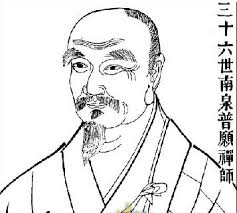Bodhidharma
Baizhang Huaihai
Caoshan Benji
Dahui Zonggao
Daman Hongren
Danxia Tianran
Dayi Daoxin
Dazhao Puji
Dazhu Huihai
Dazu Huike
Deshan Xuanjian
Dongshan Liangjie
Dōgen
Eisai
Guifeng Zongmi
Guishan Lingyou
Guizong Zhichang
Heze Shenhui
Hongzhi Zhengjue
Huangbo Xiyun
Huanglong Huinan
Huineng
Jinshan tanying
Linji Yixuan
Longtan Chongxin
Luohan Guichen
Mazu Daoyi
Nanquan Puyuan
Nanta Guangyong
Nanyang Huizhong
Nanyue Huairang
Niutou Farong
Qingliang Wenyi
Qingyuan Xingsi
Sengcan
Shishuang Chuyuan
Shitou Xiqian
Tianhuang Daowu
Xiangyan Zhixian
Xitang Zhizang
Xuansha Shibei
Xuedou Chongxian
Xuefeng Yicun
Yangqi Fanghui
Yangshan Huiji
Yantou Quanhuo
Yaoshan Weiyan
Yongjia Xuanjue
Yongming Yanshou
Yunmen Wenyan
Yunyan Tansheng
Yuquan Shenxiu
Zhaozhou Congshen
Index
Nanquan Puyuan

born
748
died
834
died place
Nanquan Mountain, Chiyang
ACHV
promote Hongzhou School
religion
Chan
teacher
Mazu Daoyi
students
Zhàozhōu Cōngshěn, Changsha Jingcen, Zihu Lizong, Tanzhao, Xitang Zhizang
Contents
Biography
Influence
Appearance in koans
Biography
In the year 795, after his enlightenment experience under Mǎzŭ, he settled in a self-made hut on Mount Nanquan, from which his dharma name is derived, and lived there in eremitic solitude for three decades. In time, monks persuaded him to come down the mountain and found a monastery; from that time forward, he always had hundreds of students.
Influence
Nánquán had seventeen Dharma successors, the most famous of whom was Zhàozhōu Cōngshěn (778-897). Case 19 of the Gateless Gate recounts an interaction between Nánquán and Zhàozhōu that led to the latter having a profound realization; some translators/editors, for example Paul Reps, interpret this as Zhàozhōu’s enlightenment moment.
Appearance in koans

Japan, Hashimoto Gahō, "Nanquan Killing the Cat"
Nanquan appears in several koans:
◦4 koans in The Gateless Gate (14, 19, 27, 34),
◦6 koans in the Blue Cliff Record (28, 31, 40, 63, 64, 69), and
◦3 koans in The Book of Equanimity (9, 69, 91).
Two koans from the Blue Cliff Record (28 & 69) depict Nanquan as an advanced student interacting with fellow students of Mǎzŭ, and the others depict him as a teacher in his own right.
A well-known koan is case 14 of the Gateless Gate, "Nansen kills the cat":
Once the monks of the eastern and western Zen halls were quarrelling about a cat. Nansen held up the cat and said, "You monks! If one of you can say a word, I will spare the cat. If you can't say anything, I will put it to the sword." No one could answer, so Nansen finally slew it. In the evening, when Joshu returned, Nansen told him what had happened. Joshu, thereupon, took off his sandals, put them on his head and walked off. Nansen said, "If you had been there, I could have spared the cat."
Contact us
Disclaimer
Comments
© Copyright Jumpypixels.com